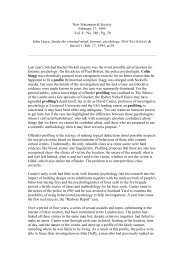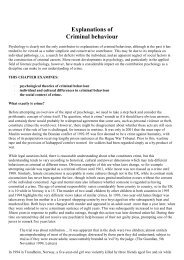Ch 11 - Jeff Standen
Ch 11 - Jeff Standen
Ch 11 - Jeff Standen
Create successful ePaper yourself
Turn your PDF publications into a flip-book with our unique Google optimized e-Paper software.
Models of abnormality<br />
Kraepelin (1855-1926) developed his classification system<br />
of psychological disorders. He distinguished between<br />
psychoses (true 'insanity' where the patient has lost touch<br />
with reality), neuroses (anxiety disorders), personality<br />
disorders, and retardation. All the classification systems used<br />
by psychiatry up to the present day are based on Kraepelin's<br />
original system (Stone, 1998). By the end of the 19th century,<br />
the biological or medical model of abnormality was<br />
dominant. Psychiatrists took control of the asylums and<br />
turned them into 'mental hospitals' housing large numbers of<br />
patients. 'Moral treatment' was seen as too time-consuming<br />
in terms of the attention it paid to the individual needs of<br />
patients. It was largely replaced by more economical<br />
treatments like physical restraint, cold baths, bleeding and<br />
purging - clearing out the stomach and the bowels.<br />
Despite its triumph, however, 19th century psychiatry was<br />
not very optimistic about its chances of curing psychological<br />
disorders (Porter, 1997). The success rate of medical<br />
treatments was poor - psychiatrists claimed this was because<br />
many disorders were inherited and therefore incurable. The<br />
only solution many psychiatrists could see lay in eugenic<br />
programmes of selective breeding and sterilisation. In the<br />
first half of the 20th century, laws were passed in many<br />
Western countries, including the USA and Scandinavia,<br />
permitting the compulsory sterilisation of the mentally 'unfit'<br />
(Summary<br />
In ancient times, an early psychological model of spirit<br />
possession was widespread. This was treated by<br />
exorcism and trepanning.<br />
In classical Greece and Rome, a biological model of<br />
imbalance of humours was favoured. This became<br />
known as the Galenic theory. Abnormality was treated<br />
with diets, exercise and drugs.<br />
During the medieval period, spirit possession and<br />
exorcism revived, and the Galenic biological model<br />
declined.<br />
In the 18th century, new psychological models<br />
emerged. Pinel's approach was influential, seeing<br />
abnormality as the result of stress, and treating it with<br />
'moral treatment'.<br />
Advances in biology and medicine led to the rise of<br />
psychiatry in the 19th century By 1900, the biological<br />
model was dominant.<br />
(Dowbiggin, 1998). In Nazi Germany in the 1930s, mental<br />
patients were gassed. Since then, eugenic programmes have<br />
been much less popular in psychiatric circles.<br />
( Unit 2 The biological (medical) model of abnormality<br />
J<br />
KEY ISSUES<br />
1. What are the main features of the biological model?<br />
2. What are the implications for treatment of this<br />
model?<br />
Main features of the biological model<br />
The biological model is favoured by medicine and<br />
psychiatry - the branch of medicine that specialises in<br />
mental disorders. The biological model was the dominant<br />
view of abnormality at the beginning of the 20th century.<br />
Despite serious challenges from various psychological<br />
models, it remains dominant today. The biological model<br />
uses the medical language of patient, symptoms, diagnosis,<br />
illness, disease, treatment and cure (Maher, 1966).<br />
Psychiatry tends to see abnormality as mental illness,<br />
although many psychiatrists now prefer the term disorder to<br />
illness.<br />
The biological model classifies mental disorders. The<br />
main classification systems in use today are the ICD-10 (the<br />
World Health Organisation's International Classification of<br />
Diseases,<br />
10th edition) published in 1993, and the<br />
American DSM-IV (Diagnostic and Statistical Manual of<br />
Mental Disorders, 4th edition,) published in 1994.<br />
Psychiatric systems classify disorders according to their<br />
symptoms. For example, both the ICD-10 and DSM-IV<br />
place depression in a category of mood disorders. The<br />
symptoms of depression include low mood, fatigue, loss of<br />
concentration, reduced sex drive, change in weight,<br />
disruption of normal patterns of sleep, slowed (or, in some<br />
cases, agitated) mental and physical activity, feelings of<br />
worthlessness or guilt, and preoccupation with death.<br />
The biological model regards psychological disorders as<br />
a sign or symptom of an underlying physical or organic<br />
disorder - usually some dysfunction of the brain or nervous<br />
system. Different psychological disorders are believed to be<br />
caused by different organic disorders. Brain scanning<br />
techniques, such as PET or CAT scans, are often used to find<br />
evidence for the physical basis for psychological<br />
abnormality. In the case of depression, PET scans suggest<br />
that depressives have a lower uptake of glucose in the<br />
brain, which may explain the slower mental functioning<br />
and loss of concentration (Lingjaerde, 1983).<br />
The brain dysfunctions and organic disorders that are<br />
believed to cause abnormality can arise in a number of<br />
ways. Some may be genetically inherited and run in<br />
families. Some may be caused by infection. Some may arise<br />
from damage to the nervous system, as a result of exposure<br />
to environmental pollution, alcohol or drug abuse, or the<br />
impact of life experiences like overwork or child abuse.<br />
Some people may be genetically more vulnerable to being<br />
155







